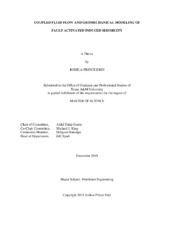| dc.description.abstract | Many unconventional shale applications in the oil and gas industry require coupling of
reservoir fluid flow with geomechanics simulations for a holistic study of formation stability. Since
traditional reservoir simulation packages normally do not fully support geomechanical effects
resulting from pore pressure change and varying stress states, finite difference flow simulators
which handle multi-phase regimes with varying fluid saturations need to be supplemented with
finite element analysis software applications that include geomechanics capabilities but might be
limited to single phase fluid flow regimes. The general theme in events leading to induced
seismicity from human interaction with the environment involves pore pressure, strain change,
total stress and effective stress variations in a reservoir system with underlying faults, undergoing
fluid injection and extraction. The objective of the current research study is to couple fluid flow
with geomechanical effects to model pore pressure, stress variations and strain change using
commercially available finite element analysis in Abaqus and finite difference analysis in CMG
for comparison. Reservoir material properties and output strain results from both CMG and
Abaqus coupled models are used to calculate induced seismic moments during unbalanced waste
water injection and brine production in a reservoir system with an underlying fault. Results suggest
that a combination of fluid flow and geomechanics can have an impact on induced seismicity. Near
fault basement strain change depends more on production pattern compared to injection pattern
variations as more compaction occurs. Unbalanced target formation injection-production activity
can lead to increased strain change and seismicity in the basement. Induced seismicity is more
related to strain change as opposed to pore pressure change for the cases studied here. | en |


